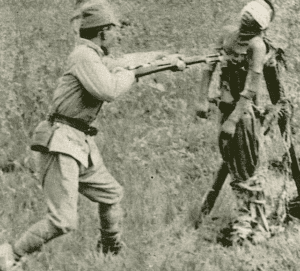Howard Fischer
Uppsala, Sweden
 |
| Bayonet practice, wherein Japanese soldiers used dead Chinese for targets. photographed by an Associated Press photographer near Tientsin. Date, 5 September 1937. Source, LIFE, Oct 11, 1937. page 30. Via Wikimedia |
In 1931 the Japanese army occupied the province of Manchuria in north-east China and continued to invade and occupy more of China as well as Southeast Asia and the western Pacific islands. The Japanese war machine needed the natural resources of these conquered territories in order to continue to expand its sphere of influence.
Waging war is very expensive—both in terms of blood and treasure. General Ishii Shirō, an army physician who had cultivated contacts among the leaders of the Japanese government, had a more economical approach to warfare: The use of bombs, explosives, and the deployment of ground forces could be greatly decreased by use of bacteriological warfare, the cost reduced and more people could be incapacitated or killed. These proposals were endorsed by the government and Ishii was given the authority to start a secret germ warfare project.
After some changes of location, the project, known as Unit 731, was set up in Pinfang, near the city of Harbin in Manchuria. Construction occurred between 1936-1939. The unit was a walled-in city of more than seventy buildings on sixty square kilometers of land. As many as 20,000 people—civilian and military technicians, nurses, and doctors—worked at Unit 731 and other germ warfare laboratories. Unit 731 had two missions: to develop treatments for Japanese soldiers suffering from local varieties of infectious diseases as well as the diseases that would be used in bacteriological warfare; and the more sinister purpose of developing agents to be used in bacteriological warfare and to perform experiments on the limits of human tolerance to extreme pressure and temperature. The victims of these experiments were mostly Chinese civilians rounded up by the kenpeitai, the Japanese military police. Other victims were prisoners of war of several nationalities, all regarded as inferior by the Japanese. To further dehumanize victims of experimentation, these people were called maruta, meaning “logs.” Local civilians were told the site was a sawmill. When bodies and body parts were incinerated, it was said that “logs were burning.”
The unit cultivated cholera bacteria and released it into civilian populations. The incubation period of cholera is long—about twenty days, so cholera is not a tactical weapon. Plague, however, starts killing victims three days after infection. Experiments showed that plague bacteria dropped by low-flying, low-velocity aircraft could infect large numbers of people. Fleas and rats were raised in massive numbers in order to have a continuous supply of plague hosts and vectors. An estimate of at least 300,000 people died of infectious diseases resulting from the work of Unit 731 and its associated laboratories.
Japan had fought and defeated Russia in 1904-5. The rulers of Japan anticipated that Japanese soldiers would also be fighting Russian troops in this war. Experience was needed in treating the frostbite expected to occur in winter, so Unit 731 conducted freezing experiments on prisoners. Victims were exposed to temperatures as low as minus seventy degrees centigrade. At this temperature all muscle and other soft tissue froze and could simply be pulled off the hands and feet.
Prisoners in Unit 731 were shot so that doctors could have experience treating gunshot wounds. The same victim would simultaneously be used for practice in performing a tracheostomy, an appendectomy, and limb amputations. Living prisoners who were operated on, (or used for bayonet practice) were usually not given anesthesia. The progression of disease was evaluated by non-anesthetized vivisection.
Experiments testing the effects of exposure to poison gas at different concentrations and for varying durations of time were also conducted.
When it was apparent that Japan had lost the war, the buildings of Unit 731 and of other similar prison-laboratories were destroyed. The remaining maruta of all nationalities were killed. General Ishii had all Unit 731 personnel swear an oath of eternal silence about their wartime activities. The defeated Japanese knew that the Americans, once they learned about the unit’s activities, would want to see the results of their experiments and would not want the results to be known by the Soviets. It was already clear that a rivalry was growing between the US and the USSR. The Americans got data from Unit 731 by offering immunity from prosecution for war crimes for Unit 731 personnel. The Russians, however, did put a number of captured Unit 731 workers on trial.
Much of this inhuman story was unknown to the Japanese public. In 1993 a privately organized exhibit about Unit 731 toured Japan for eighteen months. Former members of Unit 731, now quite elderly, came forward and revealed secrets they had been keeping for nearly fifty years.
The information in this review came from the book Japan’s Infamous Unit 731. The book’s first section is an overview of the history of military medicine in Japan and the later establishment of the bacteriological warfare program. The second half consists of testimonies from Unit 731 members given in 1993 or later.
References
- Hal Gold. Japan’s Infamous Unit 731. Rutland, Vermont. Tuttle Publishing, 2019.
- Anthony Beevor. The Second World War. London. Wiedenfeld and Nicholson, 2012
HOWARD FISCHER, MD, retired as a professor of pediatrics from Wayne State University School of Medicine, Detroit, Michigan. He is the co-editor of a textbook, Child Abuse and Neglect, and has always had an interest in the interaction of medicine and society.
Winter 2021 | Sections | War & Veterans

Leave a Reply